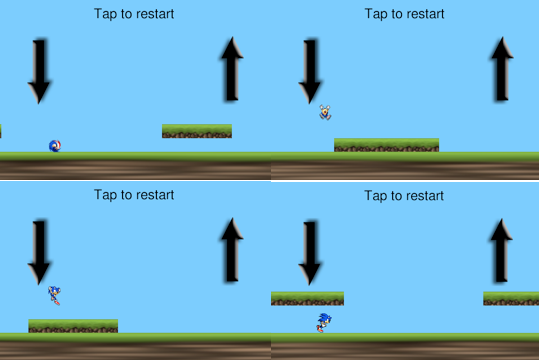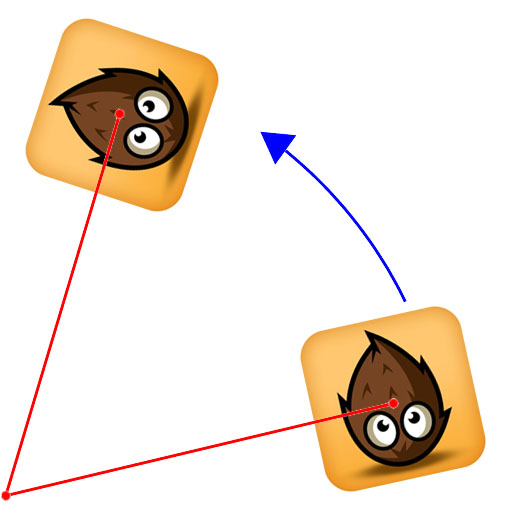 This simple game was made to demonstrate how to save time when developing a game for several different mobile platforms like iOS, Android or Bada. Because the number of mobile platforms is raising and the developers want to reach the largest possible audience, developing the game several times for every single platform separately is not an option anymore.
This simple game was made to demonstrate how to save time when developing a game for several different mobile platforms like iOS, Android or Bada. Because the number of mobile platforms is raising and the developers want to reach the largest possible audience, developing the game several times for every single platform separately is not an option anymore.
Category Archives: Tutorials
Custom cocos2d Action for rotating a sprite around an arbitrary point
Cocos2d is and excellent framework. It has saved me tons of time during my game projects. It offers almost everything I need. However, sometimes there are some features that are not supported by cocos2d.
This is the case of rotating a sprite around an arbitrary point. Rotation in cocos2d is based on the concept of anchor point. This is ok on the 99% of situations, probably. However, during the development of Muster my Monsters I need to perform rotations around arbitrary points. The idea is to have an sprite “orbiting” around another sprite or some defined point in the space.
Sprite sheets. Managing them easily on Cocos2d
In today’s post I would like to share with you a handy piece of code to manage sprite sheets. I have called it TSSpriteSheetManager.
TSSpriteSheetManager is a singleton cocos2d class that allows for easily manage sprite sheets. You just add sprite sheets to the manager and then request a sprite or frame automatically batched for you. The manager will search for the sprite in all the added sprite sheets and if it is not in any of them, it will search for individual files on your project.
You have the entire source code for this project at the end of this article.
FacebookScorer – Post highscores to user’s Facebook Wall
Today’s post is an update for an old article about posting high scores to Facebook Wall. Some users have reported some issues about this class. There were some problems with the state control when authorization was needed.
Today I will like to post a new version of the class that solves these issues. The project is now called FacebookScorer and you can find it on GitHub.
Guest post: The Making of Pigeons Attack with Cell SDK
Pigeons Attack was born as a sample to show how the accelerometer API works. You move forward and backward –tilting your phone- your just washed car in order to avoid pigeons get it dirty. Once the semaphore becomes green, leave quickly the scene to check how many impacts you had. The less you have the better.
Within the following sections you will be guided through the development process, starting from a new Cell SDK project.
In-App web browser control for iOS apps
In today’s post I would like to share with you a little piece of code. If you need to integrate in-app web browser control into your iPhone apps, this handy module will save you some time.
There are already some solutions to this problem out there but non of them offers the features I needed. First, the solution I present in this article uses a work-around for the well-known UIWebView bug that causes erratic behavior when combining “zooming operations” and “landscape orientation”. Moreover, the solution presented is highly customizable.
I have called it TSMiniWebBrowser. You can download the source code at the end of the article.
A Twitter reusable class. iOS 5.0 ready with iOS 4.x retrocompatibility
Today I would like to share with you a little but useful class to post highscores to Twitter on your games. This tutorial is the perfect companion for the Facebook one I wrote some weeks ago. It basically adds a new abstraction layer to the MGTwitterEngine from Matt Gemmel and the OAuth Twitter Engine from Ben Gottlieb providing the needed UI to send tweets to the user timeline.
The tutorial also shows how to figure out the iOS version and use the Apple’s Twitter API for iOS 5 if available.
You can download the entire project at the end of the article.
A reusable localization manager class for iOS
Today I would like to share with you a very simple and specific little class that may be very helpful if you encounter the same situation than me. Imagine that you need to manage the language of your app or game independently of the system language settings. It is kind a weird requirement but it is indeed a mandatory requirement for the iOS project I’m currently working on.
So, today I will share with you a little handy class that allows you to change the language of your app’s interface within the app and without the need of restarting. Moreover, the class uses the same dictionary system and files than the localization support offered by Apple.
An update management handy class
Today I would like to share with you a little piece of code that I find very handy. A class that helps you managing “updates”. I use it in my apps that work with cached data. You could encounter the situation where you need to develop an app that queries a web service to obtain the data to be shown on the device.
However, sometimes the information you need to access doesn’t change so often and it is not necessary to bother the user with a loading message only to end up showing the same information than 2 minutes before. If being up to date accurately is not critical for your app, the code I’m going to show may help you.
A Facebook reusable class
In today’s post I’m going to share a piece of code that allows your games to easily connect to Facebook. It is a singleton class designed to be reusable, very simple to use and with only one task in mind: post new high scores on Facebook. You can find the example project source code at the end of the article.
The aim of this post is not to teach you about how to use the Facebook API to connect your iPhone games to Facebook. There are a lot of articles covering this topic and the official Facebook developers site. In this tutorial I would like to put the emphasis on the reusable and simplicity to use aspects. It is very easy to integrate in your projects the piece of code I’m going to show you.



